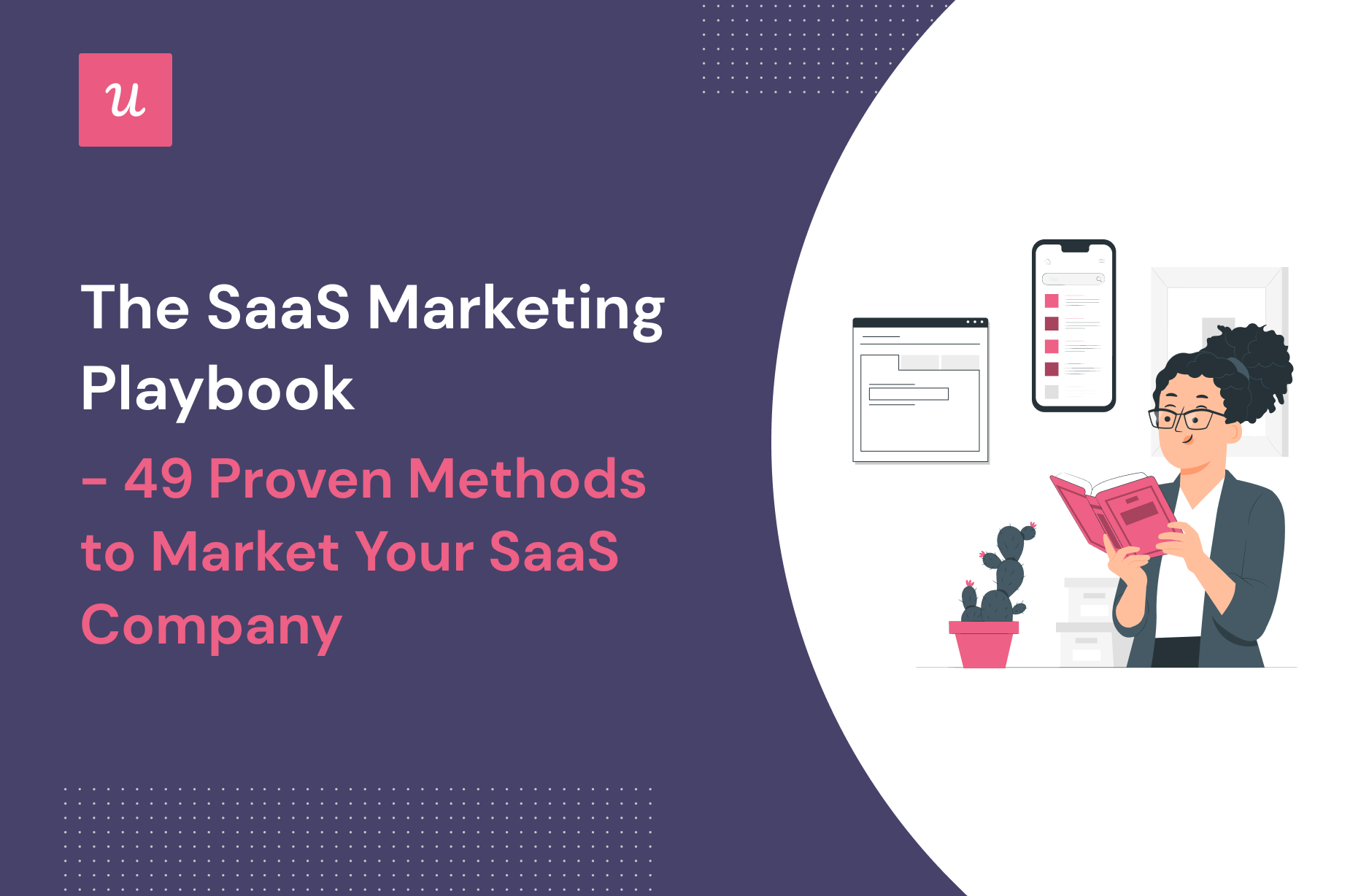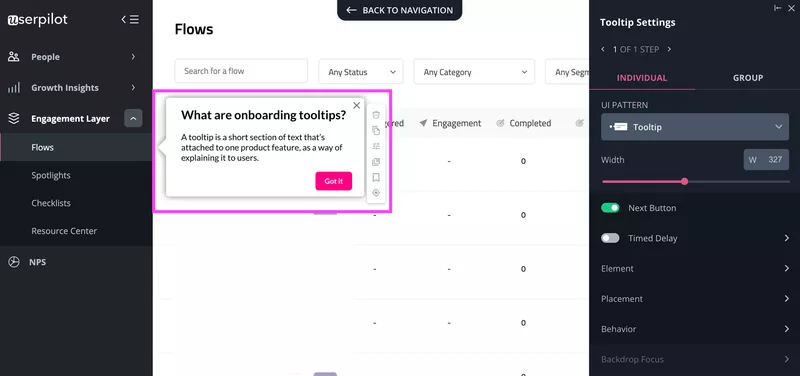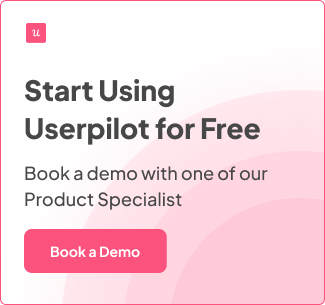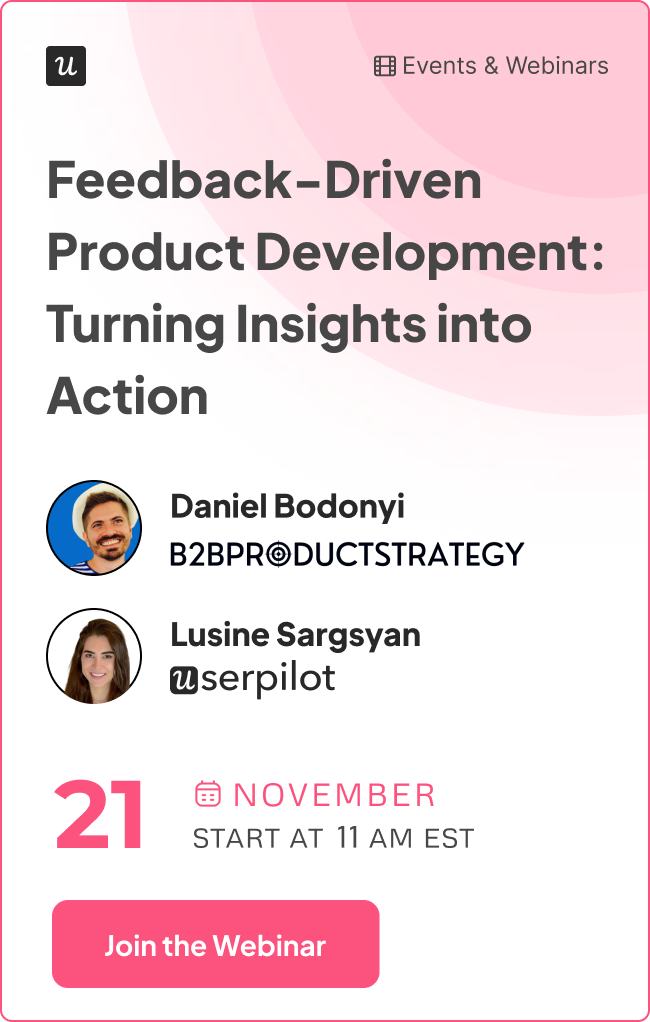The SaaS Marketing Playbook for Exceptional Growth in 2023

Why Having a SaaS Marketing Playbook is So Important
A marketing playbook is a term often used in place of a marketing strategy. Like any strategy, it is made of individual plans or ‘plays’ to achieve a company goal. In sports, that goal is to win, while at SaaS companies, it is to grow.
In SaaS, marketers have the challenging task of presenting value at scale in a crowded market. More than 7,000 SaaS companies exist in the marketing space alone. There will always be some evergreen niches, and investment is expected to increase to $623 billion in 2023.
But to succeed, you have to get the right message out, at the right time, and to as many people as you can who fit your customer persona.

Source: Userpilot-test which messaging works best for each of your segments with custom welcome screens! No coding required- talk to a product specialist today.
Let’s see what the most common SaaS marketing strategies or playbooks are. Then we can go into how some of the plays from the legendary marketing playbooks of seasoned marketing professionals have left them undefeated.
SaaS Marketing Strategies for Growth
SaaS Content Marketing
We are a world that loves consuming content.
The average daily time spent consuming content is nearly 7 hours, and SaaS companies can capture some of that daily time spent with outstanding educational and inspiring content.
Why educational and inspiring?
You want to provide value to your potential customers so that you can build an audience that trusts the information you publish. It has to be inspiring because you want people to take action on the content they consume. If your content is just a bunch of tips in an unengaging article, you may as well link to Wikipedia.
The most common content marketing assets are:
- Blogs
- Whitepapers
- Case studies
- Videos
- Infographics
- Webinars
- Software demos
- Customer Testimonials
Content marketing is a long-term investment where the ROI increases year over year. Across industries, the average ROI after three years of content marketing efforts is around $2 million.
By creating a variety of these assets and executing them in different plays’, you can also get a substantial increase in your MQLs.
But what are the plays for a SaaS marketing playbook that actually work and aren’t just “create high-quality content, promote it, and wait three years.”?
How Lemlist created a community based on email sequence teardowns, went viral on social media, and now hit 3.5M in revenue.
Vukasin Vukosavljevic
Head of Growth, Lemlist

If you’re in the B2B space, you know the importance of success stories. Yet, getting and creating them usually feels like a pain. That’s not what content creation is about. It needs to be fun.
So what we as a team did is launch the “Lemlister of the week” project. To put it simply, every week, we feature users and their campaigns.
“Instead of publishing self-promo content, we’re talking about actionable and inspirational tear-downs of their cold email templates and steps they took to achieve higher reply rates.” – Vucasion Vukosavlejvic
On the flip side, we feature their work across our entire community, 42k+ people in total. We throw in a t-shirt and a do-follow backlink in the mix too. Some users who own agencies and make sales for a living can sign new clients through the network. So not only is it quality content but a win-win deal as well.
Today, our hub is filled with various campaigns across different industries. It’s also being shared on Social Media a lot.
What’s the moral of the story? There’s always a way to improve, make quantum leaps in your work and get the job done.
One of the content marketing plays that helped Visme gain over 8 million users and pass 2M monthly organic traffic
Farzad Rashidi
Co-founder of Respona, Marketing director of Visme

Content marketing is a must when it comes to growing your audience but also authority within your niche.
Although, most people are still missing out on the most crucial part of the content marketing process… promotion!
One of my personal favorite content promotion strategies is the anchor-text campaign.
An anchor-text campaign lets you take the focused keyword of your content (blog post) and find other content that mentions it inside the body. Thus, targeting an anchor text that is relevant to your content and more likely to get a link back.
For example, if you write a guide on “podcast marketing,” it would make sense to reach out to other blogs that have mentioned that phrase in their body. Except, make sure that you are reaching out to content that isn’t in direct competition to your post; otherwise your chances of getting a link back are a lot lower.
Using advanced search operators in Google or Bing, you can search for specific keywords in the body and title of the content. Here is an example string you can throw into Bing to find blogs that mention podcast marketing in the body but mainly talk about content marketing.
By focusing on a broader topic in the title, you can find relevant content that does not directly compete with the keyword “podcast marketing.” From here, you can really personalize your pitch and start forming mutually beneficial relationships to promote your content and build backlinks from quality, relevant sites.
The first steps that Quoleady, a content marketing agency, takes to onboard SaaS clients to increase their organic traffic
Olga Mykhoparkina
Founder at Quoleady

Content marketing isn’t about producing four articles per month; it starts way ahead of that.
Understanding the business, the market, the industry, the target audience, and the buyer journey is super important to develop content ideas that will work.
If you want to succeed fast – find the high-intent keywords that your potential customers are typing in Google looking for a solution for their problem. It works like a charm every single time.
- If you are an email tool, a “Mailchimp alternatives” post will bring more leads than “a Guide to writing winning subject lines.”
- If you are automating LinkedIn outreach, The “LinkedIn automation tools” post will get more leads than “How to find leads on LinkedIn.”
- If you are a team communication tool, “Slack vs. Microsoft Teams” will bring more leads than “How to improve communication at work.”
You get the idea. Unfortunately, there aren’t always opportunities like that for every niche out there. But if you find those for your business, make sure not to miss them, as they’ll surely change your content marketing game.
3. SEO for SaaS Marketing
In the last 10 years, SEO or Search Engine Optimization has become a multi-billion dollar industry.
Cracking Google’s code is the difference between having hundreds of thousands of users visit your website every day or continuously watching only 30 people read your latest blog post.
SEO is composed of three elements:
- On-page SEO
- Off-page SEO
- Technical SEO
Both on and off-page SEO are the plays that combine well with your SaaS content marketing strategy. The first relates to literally the pages of your website—the keywords you use to describe your product in your content that matches search intent and volume.
The second is the juice that makes a website appear first in the search rankings. These are through backlinks-the more people linking to your site and content-the more credibility the google algorithm gives the content.
Then you have technical SEO where the structure and the speed of your website influence the overall grade that google will give your site over another. Whenever someone goes to your site, Google needs to crawl, index, and render it. Anything that impedes modern search engines like slow page loading times and broken links will affect your overall ranking.

SEO is a daunting task for anyone without the mildest understanding of keywords or backlinks. That is why so many SaaS marketing teams have at least one SEO specialist or outsource their SEO to agencies and freelancers.
These are the people with the specific expertise and plays to ensure their companies rank for the keywords they are writing for and capture as much traffic as possible.
Here is what some experts in SEO had to say about one tactic that changed their rankings.
One of the SEO tactics that helped Ominisend increase organic traffic by 300% in 12 months
Evaldas Mockus
Director of SEO at Omnisend

You need to cover with your content all organic searches related to your brand name. Brand Name + discount, Brand Name + reviews, comparisons with other tools Brand Name vs, etc.
Don’t let other websites get your brand traffic.
At the same time, focus on being included in the lists where your competitors are mentioned. You will get from them not only SEO juice but also real traffic and registrations.
As a product, you want to be visible in existing content where your competitors are. For example, if your product is a push notification application, you need to appear in articles like best push notifications, must-have website tools, etc.
The plays that the current Director of SEO at Shopify has used in the last 10 years to help companies acquire +100M users
Kevin Indig
Director of SEO at Shopify

First, make sure your bottom-of-the-funnel keywords are in place: “{competitor} vs. {your product},” “benefits of {your product},” “{product name},” etc.
Second, use a tool like alsoasked.com to find questions about your product and make sure you rank #1 for them.
Third, find the most critical use cases, problems, and challenges your customers to face and create content for them.
Just these three steps alone will keep you busy for a while. From there, ensure you can attribute leads and revenue correctly to SEO. Otherwise, your success will be hard to prove.
How Pictochart improved its website performance score from 23 to 95 and improved its best practices score from 54 to 93
Agata Krzysztofik
Head of Marketing at Piktochart

One of the most essential SEO projects you should focus on in 2023 is page speed improvement. In May 2020, Google announced they will include page experience signals in Google Search ranking.
In November 2020, they confirmed that this Google algorithm update would roll out in May 2021.
What will this impact?
- Your ranking in search results
- How many pages of your website get indexed
- How long visitors will stay on your site
- How much you will spend on PPC campaigns?
That’s why recently, at Piktochart, we decided to optimize our website for page load time. We did a complete redesign of our website with the following goals:
- Increase website performance score to 90
- Increase best practices score to 90
Both of the above are measured with Google’s PageSpeed Insights.
We had a particular strategy since our website is based on WordPress. We focused on developing reusable blocks to reduce the amount of code, consolidating CSS, implementing lazy load, and optimizing the website experience for mobile.
Results?
- Improved website performance score from 23 to 95.
- Improved best practices score from 54 to 93.
4. Inbound VS. Outbound for SaaS Marketing
Today’s modern SaaS company needs a mix of inbound and outbound marketing. Inbound as the name implies means customers find you, while outbound is when you go out and find them.
Choosing the right mix of inbound and outbound is like a stew. What resources you have and who you are making it for determines the ingredients you use.
Large marketing budgets allow you to take advantage of more paid search marketing and large-scale email campaigns. Smaller budgets can be creative and direct all their marketing budget towards an inbound content strategy and then have their sales reps run outbound email sequences.
Depending on what you choose, the stew will come out differently.

Source: Hubspot.com – They literally wrote the book on inbound marketing
Two examples of inbound are content marketing and SEO, as mentioned before. But there is also value in creating communities through social media or in apps like Slack and Clubhouse.
You are interacting with your customers personally by creating spaces to talk about shared interests or common pain points. This will eventually lead to product advocates.
While outbound is more complicated, it can reap quicker rewards. Email campaigns are not going anywhere.
Paid search marketing is another outbound tactic that can pay incredible dividends. With the right keywords and audience targeting, you can attract more traffic to your feature pages and get more demos scheduled.
Let’s take a look at some of the plays that helped these coaches take advantage of their marketing channels.
Inbound and Outbound Success Stories
Ognjen Boskovic
Growth Marketer at Content Distribution
Building an email list. Used it to:
- Add $2,500 MRR only a month after the launch.
- Boost specific LinkedIn posts that make us $1,650 MRR on average.
- Distribute all of our content.
- Build relationships with people.
- Drive referral traffic to our YouTube channel, give it traction…and a lot more.
- Doing great work and then documenting that in case studies.
Kristian Vanberg
Learning Technologies Lead at Dossier
What really moved the needle for our SaaS in terms of growth/marketing:
- Customer advocates.
- Becoming small customer/ecosystem communities built around common problem/solution sphere interests (first customer advisory boards, then customer events and customer presentations).
- Published case studies & ROI analyses, then organic growth on the back of that foundation.
Amar Ghose
CEO at Zenmaid.com
I would never pick one thing to do on the marketing side, but I can say the most useful thing we’ve ever done was host the first virtual summit in our industry.
For ~6 months after we ran this event, every metric in our funnel got better – more leads, better conversion rate, higher-paying average users, lower churn Combined partnerships with great content, and built us up even more as authorities within the industry.
5. Product-Led Growth in SaaS Marketing
Product-led growth marketing is when you use the product as the primary driver of acquisition.
This type of marketing also involves marketers in expansion and retention-you are following the user through their journey and providing the best product experience possible.
This marketing strategy works best if you have a freemium business model or offer a free/paid trial. Employees of an organization can choose what products they want to use instead of being forced to use specific tools by IT or operations departments in a traditional top-down approach.
As users interact with your core features, they will hit different activation points that you can qualify as leads or, in product marketer terms: PQLs (Product Qualified leads).

Source: Userpilot.com
Essentially these are leads that you get them to reach the “Aha Moment”-where they understand the value of your product. It is easier to convert them into a customer.
How to convert PQLs in SaaS Product Marketing
The key to converting PQLs into customers is the plays that you use. One example is personalized onboarding experiences based on their use case.
Many companies will just personalize a welcome screen with a generic greeting addressed to {Name}. Although there is a false sense of familiarity, it isn’t getting to the main reason why the user signed up for the product.

Source: Hulu.com
So what does tailoring your onboarding to their use case actually mean?
You can use a micro survey in the welcome screen to understand their use case and record the job they need to be done.

Source: Userpilot.com – Build and test out any welcome screen design you think of! Start creating more personalized experiences with a free consultation.
Then bring them to an onboarding that walks them through the features to help them get it done. This shows the user you are there to help them solve their problem, not just sell them on your premium plan.
You can still track each different onboarding you show them if they have hit your activation points, use your key features, and require more attention.
If they haven’t used your key features within the first seven days of their trial, an email from customer success asking if they have solved their problem establishes trust.

Source: userpilot.com
Then the next time they log in, you could show them the product features that are most relevant to their use case with tooltips or driven actions.
Source: Userpilot
Once you can base your customers’ activity on their engagement with your core features, you will also know what in-app experiences you should be presenting to new PQLs to convert them.
Of course, these plays are a bit more complicated and can require throwing another task at your developer or using no-code options.
Three Product-led growth principles that take mid-market companies to the next level
Aazar Ali Shad
Head of Growth at Vitals

At mid-stage, you have already found out that something is working. You have a product-market fit and a channel to acquire users. Some things might be broken, but overall, you have a good product that people need.
Of course, at this stage, many of the customers you acquired were because of your price points, or because there was excellent customer support. However, these elements will only take you so far.
For mid-stage, I’d recommend the following.
- Fix your positioning and make it tighter- When someone comes to your website they should immediately have a clear idea of what you do in the market, how you are different, and they understand your story. This distinguishes you from the competition and shows how you fit a specific user’s problem.
- Fix the funnel, so you don’t have any leakage-Look at your retention rates. If users don’t keep coming back then you have a retention problem. If you don’t have enough customers in your highest pricing plan then you will have a revenue growth problem. Creating product experiences that point users to the features they need helps to retain users. Showing in-app messages to active customers about the value of upgrading helps bring clients into your premium pricing.
- Work on monetization, To increase ACV- Having an upsell package is a great way to increase your product offering while also increasing your revenue. At my new company, Vitals, we will have a custom package where we also provide concierge services. Not only providing a service but also doing the job for them.
Launching a product-led growth strategy and getting a community of over 50,000 active users. Closed $12m in ARR last year.
Dan Schoenbaum
Managing Partner at High Tide Advisors

Launched a product-led growth strategy and got a community of over 50,000 active users. It closed $12m in ARR from that cohort last year. How?
- Make signup fast, simple, and frictionless-Don’t start with a long sign-up form. Ask for a phone number, or have a sales rep reach out immediately. While these may sound obvious, I see all three of these bad practices too often.
- Personalized onboarding -Studies show that personalizing onboarding can increase user activation by over 100% and retention by over 50%.
- Monitor user behavior and capture everything you can design your product to monitor user behavior to improve user experience and make real-time recommendations to the user to provide additional value incentives (for example: invite your team and unlock additional capabilities.)
- Using a Freemium or trial business model–Freemium product offerings feed the top-of-funnel much more than any trial or sales demo. Companies I previously led embraced this model over the free trial, and it helped proliferate brand awareness (over 1,000,000 sign-ups in one case) and create powerful user communities enhancing virality. This model requires more patience, and may initially delay growth, as you wait for customers to build the affinity required to convert to paid. Conversely, product trials drive urgency to evaluate and purchase — thus conversion from free to paid will be higher in the trial model. In terms of driving near-term revenue, a free trial is the better option.
Wrapping Things Up for SaaS Marketing
The coach or marketing manager of a SaaS that comes up with their plays would be nothing without their players. The SaaS playbook above was made through the collective experience of marketers going out every day trying new things and executing their plans.
How do you also improve your playbook?
Research through blogs like this one. Listen to podcasts. Join communities on social media and through different apps and networks. Exchange ideas and experience and see what has worked for other people.
Take courses and research your field. Understand the market from an academic perspective.
If there is one play in the SaaS world that always works, it is to never stop shipping new ideas.


